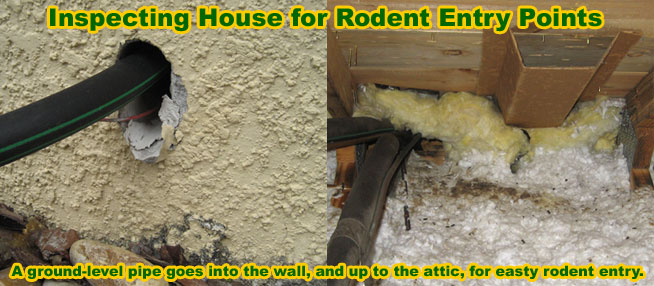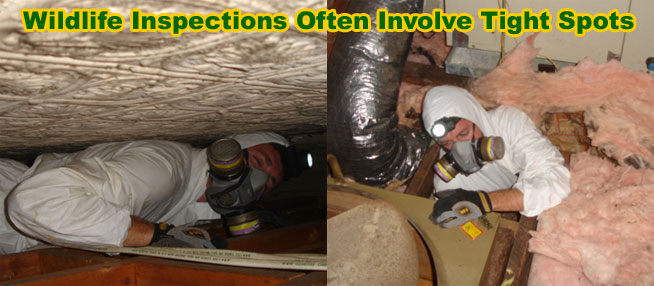This is the key - you will never solve your rodent problem
in a building until you can find out how the rats are
getting into the building in the first place. They can get
in via so many areas - they only need a hole the size of a
quarter, or a gap that is about 3/4 of an inch. Heck is
seems like even 5/8 inch is fine. Check every vent - gable
vents, roof vents, ground-level crawl space vents, even the
laundry vent. Check all doors and windows. Check every part
of the roof, especially the fascia, and wherever an eave
meets the roof. Check all roof lines. If you have a tile
roof, you've got a TON of entry spots. Check plumbing
stacks, air conditioner chases, power line enry points,
basically, EVERY SQUARE INCH OF THE HOUSE.

Here are four small examples of easy-to-spot rat entry points. In the upper-left, there's a hole that's been chewed out at the end of a gable intersection with a roof. Roof edges, and anywhere where roof meets roof is a rat entry hot spot. In the upper-right, a very obvious chewed-open ridge cap plug. The open ridge cap goes right into the attic, of course. This is a popular rat and mouse entry point. In the lower-left, it's some wires going into a gable vent, and only a flimsy screen blocks access. You can see how easy it is for the rats to chew through and slip into the attic. In the lower-right, it's a chewed out hole by a soffit vent. Never mind that the cover is in place, rodents can gnaw a hole open in the wood. Read about What can rats climb?
SAFETY CONCERNS

WHY IS THE INSPECTION IMPORTANT?

The above photo reveals a pretty easy rat entry point. You can see what happens. Rats love to find small holes and climb pipes and wires up walls and into the attic. But most entry points are not this obvious or easy to reach. Sometimes rats can get in under the house, even by digging. Read about Do rats dig holes? Do they burrow under houses? How deep?
IT AINT ALWAYS EASY

THE SAME APPLIES TO MOUSE REMOVAL
Read more articles about rats:
Do rats destroy insulation in an attic?
Do rats chew on wires? Why?
What can rats chew through?
Will a rat chew through the ceiling?

It is absolutely frustrating to find out that your beautiful home is infested with rats. However, do not panic! This is a common problem and there are many ways for you to get rid of it. One of the best strategies you can do at the onset is to patch up entry holes. In this article, you will learn about the effective ways to find these openings and how to repair them.
- Read up on the behavior of rats.
This tip must sound very geeky and boring to you but it is the same as what you are doing right now - do your research. By getting more information about the type of rat that you are dealing with, you can get specific clues on how you can better locate the cracks and gaps that they use as entry points to your home.
- Know the architectural design of your home.
It is important to know the design of your home to identify hidden holes or openings that can serve as entry points for rats. Some openings can be obvious like vents, wall holes, and chimneys while some can be tricky to spot. You may have damaged walls that you are unaware of. Take a closer look at your house’s blueprint and identify possible rat entry points.
- Look for chew marks and shavings.
These rodents chew on almost everything. If you see scratch marks or tooth marks on the surface of any wooden or light material, there is a good chance that there are wall cracks or holes nearby.
Keep in mind that this is a game of patience and thoroughness. The only way you can successfully get rid of rats in your property is to patch up the holes that they use as entry points.
- Look for urine and rat droppings.
Rat droppings are notably more pointed compared to other rodent droppings. It can measure to about ⅛ inch long. Rat urine has a pungent smell and can leave stains on wooden cases like cabinets, doors, baseboards, and windows. Once you spot these rat wastes, check for holes in walls, windows, and the roof.
- Listen to rat noises.
Up your detective game by taking advantage of the night to observe the movement of rats in your home. Listen for squeaks, chirping, and scratching sounds. The best-case scenario is for you to catch them in the act of passing through an entry point. This way, you can patch it up right away and prevent them from coming back.
- Check for trails and rat tracks.
Rats have poor eyesight so they are highly dependent on routes that they create to guide them in and out of their nest. Look for tracks and follow the trail. It should lead you to some type of hole or opening that they use as an entry point.
- Search for any small dugouts.
Widen your search by also looking into entryways, foundations, and corners. These are favorite spots for rats. They like hanging out in dark and unsanitary parts of the house so be prepared to get your hands dirty. Use gloves and masks and protect yourself from all possible contact with rats.








